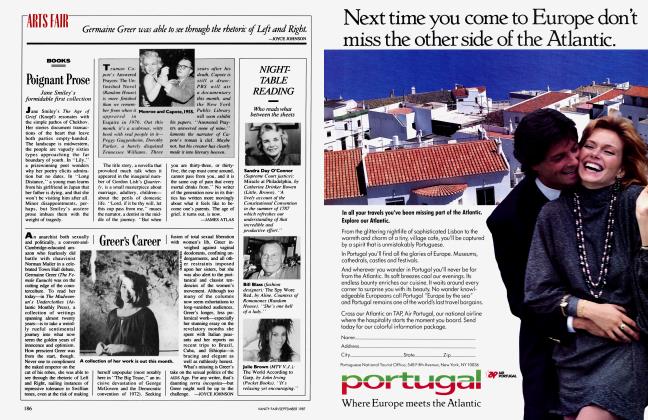Sign In to Your Account
Subscribers have complete access to the archive.
Sign In Not a Subscriber?Join NowYou Can Go Home Again
BOOKS
Darryl Pinckney
Solitary summer travelers armed with a book have a better chance of outwitting the irritations of delayed departures, missed connections, crowded lounges, and long lines. They are not wandering through aisles of unwanted souvenirs, trying to make friends, or dulling their senses in front of pay-TV. Their journey has already begun, in an obscure comer, with a paperback of a classic or with something remarkable discovered among the avalanche of this summer's first novels.
Andrew Mavis, the young stock-car racer in Kim Chapin's Dogwood Afternoons (Farrar, Straus and Giroux), embarks on an inward voyage. As he circles the track in his practice laps, he remembers his southern boyhood and his family of outrageous characters, from whom he inherited his passion for speed. Mavis's hometown, Four Corners, was an isolated spot in the foothills with "an unincorporated population of 493.'' Among the 493 were the "trippers"—men who drove the whiskey cars, with the revenuers not far behind on the blacktop. "Basically... there were two kinds of trippers. One type was quiet, sneaky; then there were the crazies." Mavis's father, Wylie, a war hero, returns to this honored profession in 1945. Mavis follows at age twelve. Dogwood Afternoons is a romance of man and machine, a tale of friendship, and a reverie on recklessness, on collisions as a form of camaraderie.
The childhood memories of west Ireland's dour landscape and reticent but volatile people haunt the hero of Carlo Gebler's The Eleventh Summer (E. P. Dutton). Paul Weismann, whose mother may have been a suicide, is left in the care of his gruff grandparents, the O'Bernes, on their deteriorating farm. Grandfather is prone to ruinous bouts of drunkenness, bouts set off by bad luck, and there is much humor in his willful and unpredictable behavior. Everything Gebler presents about Paul's physical relation to his small, confined world is superb: the shame of having wet his pants; his first sexual exploration, with his docile, smiling cousin Philomena. Gebler deftly delineates Paul's psychology—from his fear of his grandfather and strong affection for his grandmother to his attempts to translate the cryptic conversations of adults and his contemplation of the hole left in his life by his mother's absence. "Paul felt his mind was emptying and that the walls of the room were moving away from him. It was like being in a dream. It was always like this before the onset of grief." It is a melancholy life, full of the small but painful struggles of a boy somewhere between childhood and adolescence.
Lives of the Saints (Knopf), which appeared earlier in the summer season, also celebrates the past, the hometown—in this case the lush, overgrown gardens of New Orleans and the endearing eccentricities of its high society. Nothing could be more unexpected than the charm and grace of Nancy Lemann's first novel, for it avoids the sentimentality one would expect of a work about the disordered lives of well-to-do Southerners. It has the gentle tone of a lost summer romance.
Louise Brown has returned from college in the East ("that hub of the universe") to the spellbinding city of glittering nights, crumpled seersucker suits, gin and tonics, monumental oaks and palms, and the catastrophes large and small that take place in the antebellum houses. Through Lemann's language one senses the claim the city's hypnotic "madcap elegance" has on Louise's imagination.
Into the tropical abundance of the Gulf South, Lemann introduces an array of distinctive characters, full-blown with their courtesies, tics, loyalties, and bizarre homespun philosophies. Her insights are witty, dialogue memorable, and style original. "Crowded parties like at the Stewarts' often can be known to Bring On Breakdowns. Especially if the Stewarts are the hosts. .. .Everyone was too drunk. Everyone was unglued." This tight, insular society meets at weddings and funerals: bachelors scream along to scratchy jazz; matrons, in their total recall of what hats they wore in 1912, exhibit the heroism of triviality. New Orleans is, to Louise, inseparable from the families whose members fall apart twice a day and yet do their duty, carrying their dignity in defeat into the faded hotels, the torpid offices, the abandoned plantations. But it is also the story of her love for Claude Collier and the stoical, doomed Collier family.
Claude is in his twenties, a strange, impenetrable, elusive character who is burdened with a gift for generosity and a complete indifference to his own wellbeing. "Claude stopped and pointed out the jasmine and the cicadas in the night. That was his innocence to me. . . . For in Claude Collier I saw my very youth, a fateful green garden, parades on the Avenue, an orchestra on a bandstand, my youth in New Orleans." Louise's tale of decency and self-destruction is poignant, serious, subtle. Lives of the Saints, in its flow of observations and feelings, is a superb portrait of a people whose day is not yet done.
 View Full Issue
View Full Issue












Subscribers have complete access to the archive.
Sign In Not a Subscriber?Join Now